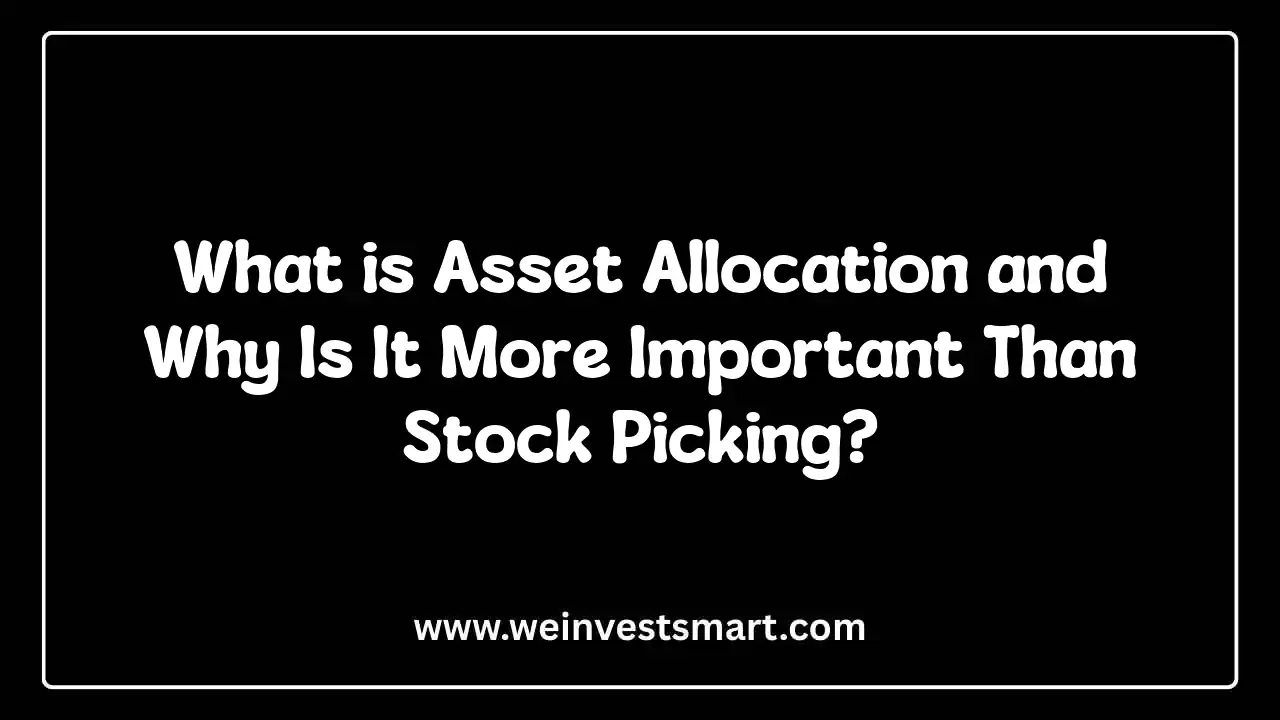· WeInvestSmart Team · investment-strategies · 10 min read
Saving vs. Investing: Why Your Savings Account Won't Make You Rich
Explain the concepts of inflation and the power of compound growth. Use a simple chart to show how money in a savings account loses value over time, while invested money grows exponentially.
Most of us were raised on a simple, comforting financial mantra: “A penny saved is a penny earned.” We were taught to work hard, spend less than we make, and diligently squirrel away the rest in a savings account. It’s the gospel of financial responsibility. But here’s the uncomfortable truth: that advice is dangerously incomplete. Following it blindly is a guaranteed path to falling behind financially. Going straight to the point, your savings account will not make you rich. In fact, it’s quietly making you poorer every single day.
We live in a world where “saving money” is seen as the ultimate virtue. It feels safe, predictable, and responsible. We can log into our bank app and see the exact number, a comforting digital security blanket. Investing, on the other hand, feels like a casino—risky, complicated, and reserved for Wall Street wizards.
But what if we told you that the “safe” option is actually a guaranteed loss over time? And what if the “risky” option is the only proven path to building long-term wealth? Here’s where things get interesting. The entire conversation around saving vs. investing is fundamentally misunderstood. They are not two competing strategies; they are two different tools for two completely different jobs. And using the wrong tool for the job is the single biggest mistake keeping most people from achieving their financial goals.
The Foundation: Understanding the True Purpose of Saving and Investing
Before we can compare, we must define. People use the terms “saving” and “investing” interchangeably, but they are polar opposites in both function and purpose.
What is Saving?
Going straight to the point, saving is the act of putting money aside in a safe, liquid, and easily accessible account for short-term needs. The primary goal of saving is capital preservation. That is to say, its job is not to grow your money, but to ensure that the money is there, in its entirety, when you need it.
- The Tool: A high-yield savings account or a money market account.
- The Time Horizon: Short-term (typically anything less than five years).
- The Purpose: Your emergency fund, a down payment for a house you plan to buy next year, or saving for a big vacation.
What is Investing?
Going straight to the point, investing is the act of using your money to purchase assets that have the potential to generate returns and grow in value over time. The primary goal of investing is capital growth. Its job is to make your money work for you, creating more money.
- The Tool: The stock market (through index funds, ETFs, individual stocks), real estate, bonds.
- The Time Horizon: Long-term (typically five years or more).
- The Purpose: Retirement, your children’s college education, or achieving financial independence.
You get the gist: Saving is for security. Investing is for growth. One is your financial shield; the other is your financial sword.
The Silent Thief: Why Your Savings Account is Losing a Battle Against Inflation
So, if your savings account is so safe, what’s the problem? The problem is a powerful, invisible force called inflation.
Going straight to the point, inflation is the rate at which the general level of prices for goods and services is rising, and subsequently, the purchasing power of currency is falling. And this is just a very long way of saying that your money becomes less powerful over time. The dollar in your pocket today will buy you less stuff next year than it does right now.
The funny thing is that we see inflation all the time, but we don’t always recognize it. We complain that a movie ticket used to cost $5 and now it’s $15, or that a gallon of milk is more expensive than last year. That’s inflation in action.
Here’s where things get interesting. Let’s look at the math. A good high-yield savings account might pay you 1.5% in interest per year. But if the average rate of inflation is 3% per year, what’s happening to your money? 1.5% (Interest Earned) - 3.0% (Inflation Rate) = -1.5% (Real Return)
The uncomfortable truth is that your “safe” savings are experiencing a negative real return. You are losing 1.5% of your purchasing power every single year. Your account balance is going up, which feels good, but what that money can buy in the real world is steadily going down. It’s like trying to walk up a down escalator; you’re putting in the effort, but you’re still moving backward.
The Eighth Wonder of the World: The Power of Compound Growth
If inflation is the villain of our story, then the hero is an even more powerful force: compound growth. Albert Einstein reportedly called it the eighth wonder of the world, stating, “He who understands it, earns it… he who doesn’t, pays it.”
Going straight to the point, compound growth (or compound interest) is the return you earn on your original investment, plus the returns you earn on the accumulated returns. It’s your money making babies, and then those babies making their own babies. It creates a snowball effect that starts small but becomes an unstoppable avalanche over time.
Let me explain with a simple example. Imagine you invest $1,000 and it earns a 10% return in the first year. You now have $1,100. The next year, you don’t earn 10% on your original $1,000; you earn it on the new, larger total of $1,100. So you earn $110, bringing your total to $1,210. The year after, you earn 10% on $1,210.
This sounds like a trade-off, because investing involves short-term risk, but it’s actually a desirable thing for long-term goals. We covet this compounding because it is the only force powerful enough to consistently outpace inflation and build real, meaningful wealth. Your savings account might earn simple interest, but it can never harness the exponential power of compounding that the stock market can provide.
The Tale of Two Timelines: A 30-Year Case Study of Saving vs. Investing
Enough theory. Let’s see what this looks like in the real world with a concrete case study.
Let’s imagine two friends, Saver Sarah and Investor Ivan. Both are 30 years old. They each start with an initial lump sum of $10,000 and commit to putting aside an additional $500 per month for the next 30 years, until they are 60. They contribute the exact same amount of money: a total of $190,000 over three decades. The only difference is their strategy.
- Saver Sarah is cautious. She puts her money into a high-yield savings account, earning a generous and stable average of 2% APY.
- Investor Ivan understands the need for long-term growth. He puts his money into a low-cost S&P 500 index fund, which has a historical average annual return of around 8%.
Here’s how their financial journeys unfold:
| Years | Total Contributed (Sarah & Ivan) | Saver Sarah’s Balance (2% APY) | Investor Ivan’s Balance (8% APY) | The Difference |
|---|---|---|---|---|
| 10 | $70,000 | $81,400 | $119,700 | $38,300 |
| 20 | $130,000 | $171,000 | $343,200 | $172,200 |
| 30 | $190,000 | $271,000 | $791,500 | $520,500 |
But what do we do with this information? And here is where things get interesting. Look at the staggering difference in the final outcomes.
After 30 years of identical effort and discipline, Investor Ivan has over half a million dollars more than Saver Sarah. Sarah’s money grew, but it barely outpaced inflation. Her $271,000 has the purchasing power of what roughly $150,000 had when she started. She preserved her capital, but she didn’t build significant wealth.
Ivan, on the other hand, harnessed the power of compound growth. His money worked harder for him than he worked for it. His final portfolio consists of $190,000 of his own contributions and over $600,000 of pure growth. That is how you fund a comfortable retirement. That is how you build long-term wealth.
So, When Should You Save and When Should You Invest?
The case study makes it clear that investing is the path to wealth. But that doesn’t mean you should abandon your savings account. Remember, they are different tools for different jobs.
Going straight to the point, here is a simple framework for deciding where to put your next dollar:
You should SAVE money for goals that are:
- Short-Term (less than 5 years): The stock market is too volatile for short-term goals. You can’t risk your house down payment being down 20% the year you need to buy.
- Essential for Security: Your emergency fund (3-6 months of living expenses) must be in a liquid, safe savings account. Its job is to be there, not to grow.
- Specific and Predictable: Saving for a car, a wedding, or a big trip.
You should INVEST money for goals that are:
- Long-Term (5 years or more): This long time horizon gives your investments plenty of time to recover from market downturns and for compounding to work its magic.
- Focused on Growth: Your primary goal for this money is for it to grow substantially over time.
- Abstract and Far in the Future: Retirement is the perfect example. You are steadily building a nest egg that you won’t need to touch for decades.
The Bottom Line: Making the Mental Shift from Saver to Investor
The debate over saving vs. investing isn’t about choosing one over the other. It’s about understanding that a healthy financial life requires both. You need a foundation of safe, accessible savings to protect you from life’s emergencies. But once that foundation is in place, every long-term dollar you have should be put to work through investing.
And this is just a very long way of saying that it’s time to change how you think about money. Stop seeing your savings account as your primary wealth-building tool. It is your financial safety net, nothing more. The real engine of your financial growth will be your investment portfolio.
Making this mental shift—from a primary “saver” mindset to a primary “investor” mindset—is the most critical step you can take toward securing your financial future. The numbers don’t lie. Start today, stay consistent, and let the eighth wonder of the world work its magic for you.
Saving vs. Investing FAQ
What’s the difference between saving and investing?
Saving involves putting money aside in safe, liquid accounts like high-yield savings for short-term needs and capital preservation. Investing involves using money to purchase assets like stocks that have growth potential over time.
Why is investing better than saving for long-term goals?
Investing harnesses compound growth, where returns earn their own returns, outpacing inflation. Saving in traditional accounts often loses value to inflation, while investing can build substantial wealth over decades.
What is compound growth?
Compound growth is when your investment returns earn additional returns. For example, if you invest $1,000 earning 10% annually, you earn $100 the first year, then 10% on $1,100 the next year, creating exponential growth over time.
How does inflation affect savings?
Inflation reduces the purchasing power of money over time. If savings earn 2% interest but inflation is 3%, your real return is -1%, meaning your money buys less each year despite the balance increasing.
When should I save vs when should I invest?
Save for short-term goals (less than 5 years) like emergencies or vacations in safe accounts. Invest for long-term goals (5+ years) like retirement in assets that can grow and beat inflation.
This article is for educational purposes only and should not be considered personalized financial advice. Consider consulting with a financial advisor for guidance specific to your situation.



